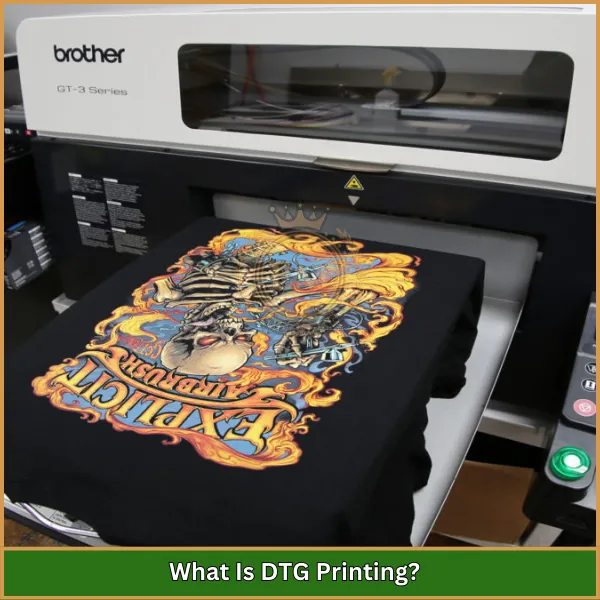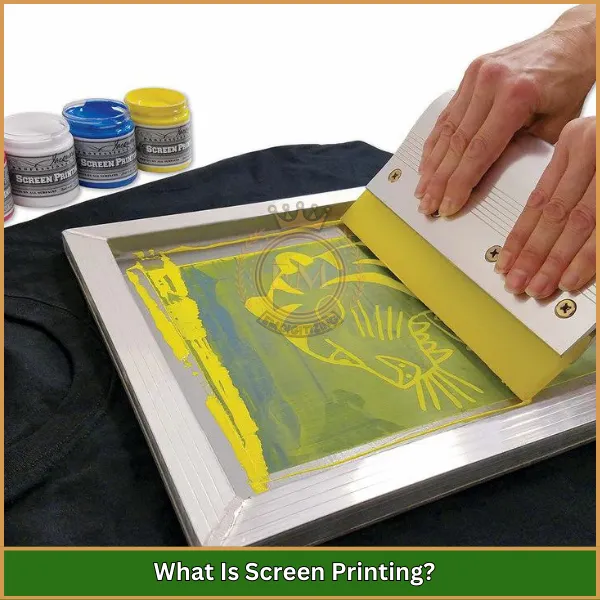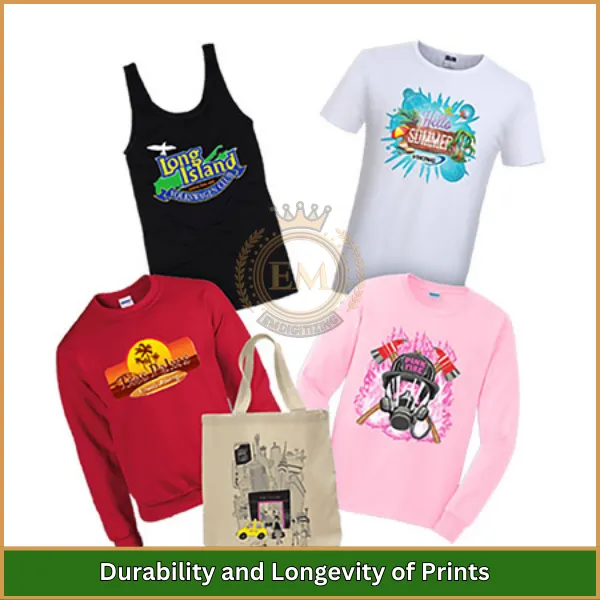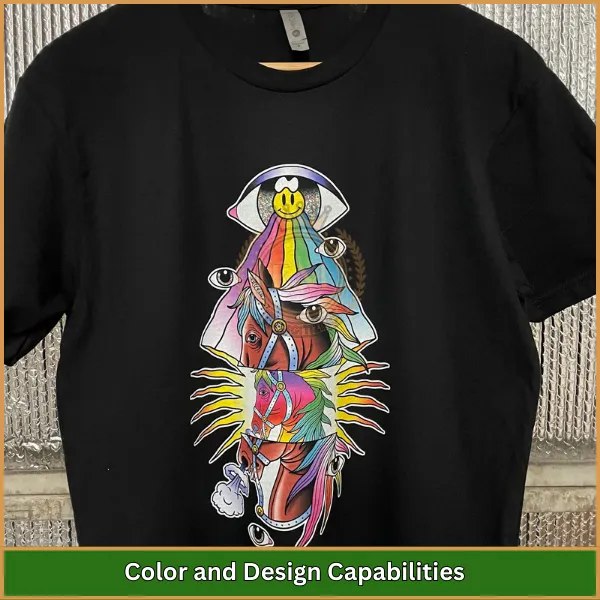Ti stai chiedendo se scegliere la stampa DTG o la serigrafia per il tuo prossimo progetto di design personalizzato?
It’;s a common question when you’;stai decidendo come stampare su tessuto, ed entrambi i metodi hanno i loro punti di forza.
DTG è ottimo per i dettagli, disegni colorati, mentre la serigrafia è ideale per ordini più grandi e colori vivaci. In questo articolo, ti guideremo attraverso le principali differenze tra i due, in modo da poter scegliere l'opzione migliore per le tue esigenze specifiche.

Esploriamo quale metodo funzionerà meglio per il tuo progetto!
Scegliere tra DTG e serigrafia per il tuo prossimo progetto
Che cos'è la stampa DTG?

Diretto all'indumento (DTG) la stampa è un metodo moderno che prevede la stampa di disegni direttamente sul tessuto utilizzando una stampante a getto d'inchiostro specializzata.
Il processo funziona in modo simile a come funziona una normale stampante domestica, ma invece della carta, stampa su tessuto, principalmente magliette.
La stampa DTG consente di realizzare progetti ad alta risoluzione con colori vivaci e grafica dettagliata, rendendolo ideale per coloro che desiderano disegni intricati e colorati sul proprio abbigliamento.
Vantaggi principali
- Elevata precisione del colore e gradienti: La stampa DTG eccelle nella gestione di progetti complessi con sfumature di colore e dettagli intricati. È perfetto per opere d'arte che richiedono un'ampia gamma di colori e sfumature.
- Adatto per piccoli ordini: If you’;stiamo producendo un piccolo numero di camicie o articoli personalizzati, DTG is cost-effective because it doesn’;Non richiede molto tempo o materiali di preparazione.
- Facilità di personalizzazione: DTG è perfetto per disegni unici o articoli in cui ogni pezzo necessita di una leggera variazione, come nomi o numeri personalizzati sulle maglie.
- Tempo di installazione minimo: A differenza di serigrafia, DTG printing doesn’;Non è necessario un lungo processo di installazione, rendendolo una scelta eccellente per gli ordini urgenti.
Svantaggi
- Limitazioni con ordini all'ingrosso: DTG non è conveniente per ordini di grandi dimensioni poiché il costo per articolo rimane relativamente elevato rispetto alla serigrafia, che diventa più economico con più unità.
- Durata delle stampe più breve su alcuni tessuti: Le stampe DTG potrebbero non durare quanto i disegni serigrafati, soprattutto su tessuti sintetici. Il lavaggio e l'uso possono causare scolorimento nel tempo.
- Preferenze di materiali specifici (100% cotone): DTG funziona meglio su 100% indumenti di cotone. Potrebbe non funzionare bene su tessuti sintetici come il poliestere, limitandone la versatilità materiale.
Cos'è la serigrafia?

È conosciuta anche come serigrafia, è un metodo tradizionale che esiste da decenni. Implica l'uso di stencil (o "schermi") per premere l'inchiostro sul tessuto a strati.
Ogni colore nel disegno richiede uno schermo separato, rendendolo un processo più dispendioso in termini di tempo, ma i risultati sono duraturi e vibranti.
Vantaggi principali
- Ideale per la stampa in serie: Diventa più economico con ordini più grandi perché il costo di installazione è distribuito su molte unità, riducendo il costo per articolo.
- Ricco, Colori vibranti: Questo metodo produce colori altamente saturi e opachi, che sono eccellenti per disegni audaci che devono risaltare su qualsiasi tessuto.
- Efficienza dei costi per lotti di grandi dimensioni: Una volta impostate le schermate, il processo di stampa vero e proprio è rapido, rendendolo molto conveniente per grandi tirature.
- Versatilità su diversi materiali: Può essere applicato ad una vasta gamma di materiali, compreso il cotone, poliestere, metallo, bicchiere, legna, e altro ancora.
Svantaggi
- Tempo di installazione lungo: Ogni colore nel disegno richiede uno schermo separato, che richiede tempo per essere preparato. Ciò lo rende meno efficiente per ordini piccoli o una tantum.
- Più costoso per ordini più piccoli: I costi di installazione di questo metodo di stampa possono renderlo costoso per piccole tirature. Il prezzo unitario diminuisce con quantità maggiori ma rimane elevato per lavori più piccoli.
- Funzionalità limitate di colore e dettaglio: Mentre è ottimo per i colori vivaci e solidi, lotta con dettagli intricati e gradienti complessi che DTG può gestire facilmente.
Differenza chiave tra DTG e serigrafia
Immergiamoci nelle principali differenze tra DTG e serigrafia, così potrai fare la scelta migliore per le tue esigenze.
Processo di stampa e tempo di configurazione

DTG utilizza un semplice processo a getto d'inchiostro che stampa direttamente sul tessuto con una configurazione minima, rendendolo ideale per lavori veloci e piccoli ordini. Questo processo consente di applicare disegni dettagliati e un'ampia gamma di colori senza troppa preparazione.
D'altro canto, la serigrafia richiede la preparazione di più schermi per ciascun colore, che aumenta notevolmente i tempi di configurazione. Per disegni multicolori complessi, la serigrafia può richiedere molto tempo, ma diventa efficiente se prodotto in grandi quantità.
Questa differenza di configurazione rende la stampa DTG e la serigrafia una considerazione chiave, especially if you’;abbiamo un programma serrato.
Efficacia dei costi per volumi diversi
Uno dei principali fattori da considerare è il rapporto costo-efficacia. La stampa serigrafica diventa più economica all'aumentare del volume poiché il costo per unità diminuisce una volta impostati i telai. Questo è il motivo per cui è il metodo preferito per lotti più grandi abbigliamento personalizzato.
In contrasto, DTG è più adatto per ordini più piccoli perché non richiede una configurazione costosa, ma il costo unitario rimane più elevato per grandi quantità. If you’;stai decidendo tra DTG e serigrafia per un ordine all'ingrosso, la stampa su schermo sarà probabilmente la scelta più economica.
Durabilità e longevità delle stampe

La durabilità del DTG rispetto alla serigrafia è un altro punto cruciale. La stampa su schermo generalmente produce stampe più resistenti e durature.
L'inchiostro utilizzato nella serigrafia penetra in profondità nel tessuto, rendendolo resistente ai lavaggi e allo scolorimento nel tempo.
Stampe DTG, pur essendo in grado di produrre immagini vivaci e dettagliate, potrebbe sbiadire più rapidamente con lavaggi ripetuti, soprattutto se non curato adeguatamente.
Per indumenti che saranno soggetti a usura e lavaggio frequenti, la sua controparte è spesso l'opzione più duratura.
Versatilità nell'utilizzo di tessuti e materiali
Quando si tratta di scelte di tessuto, la serigrafia offre maggiore versatilità. Questo metodo può essere utilizzato su una vasta gamma di materiali, compreso il cotone, poliestere, pelle, e anche superfici non tessili come legno o metallo.
DTG, però, funziona meglio su tessuti di cotone e misto cotone grazie al modo in cui l'inchiostro aderisce al materiale. Ciò limita l’applicazione di DTG a determinati tipi di indumenti e progetti, rendendo la stampa su schermo la scelta migliore per diversi tipi di tessuto.
Funzionalità di colore e progettazione

Per disegni complessi con molti colori, DTG brilla davvero. Gestisce modelli complessi, gradienti di colore, e immagini dettagliate con facilità, producendo stampe ad alta risoluzione in grado di replicare quasi qualsiasi disegno. In contrasto, la serigrafia è più adatta per il grassetto, colori solidi.
Mentre può produrre disegni multicolori, ogni colore aggiuntivo richiede uno schermo separato, che può aumentare i tempi e i costi del progetto.
Confrontando la qualità della stampa DTG e serigrafica, DTG è l'opzione migliore per i progetti che richiedono un elevato livello di dettaglio e molti colori, mentre la sua controparte è ideale per le cose più semplici, disegni più audaci.
Le migliori situazioni per utilizzare DTG rispetto alla serigrafia
Le migliori situazioni | DTG | Serigrafia |
Dimensione dell'ordine | Ordini medio-piccoli | Ordini di grandi volumi |
Complessità progettuale | Alta risoluzione, dettagliato, e multicolore | Semplice, disegni audaci con meno colori |
Tempo di consegna | Produzione rapida, configurazione minima | Configurazione più lunga, più velocemente per grandi quantità |
Idoneità del materiale | Meglio per 100% cotone e miscele di cotone | Funziona su una vasta gamma di materiali (per esempio., poliestere, pelle, eccetera.) |
Efficienza dei costi | Più conveniente per piccole tirature | Più economico per ordini all'ingrosso |
Durata | La durata moderata può sbiadire con il lavaggio | Altamente durevole, stampe di lunga durata |
Personalizzazione | Ideale per la personalizzazione, disegni unici | Più adatto per progetti ripetuti e produzione di massa |
Impatto ambientale | Utilizza inchiostri a base acqua, ecologico per piccoli lotti | Maggiore spreco di inchiostro, non altrettanto rispettoso dell'ambiente per i piccoli ordini |
Linea di fondo
La scelta tra DTG e serigrafia dipende da ciò di cui hai bisogno. DTG è ottimo per i piccoli, disegni colorati, mentre altri metodi di stampa funzionano meglio per grandi ordini con design semplici. Conoscere la differenza ti aiuta a scegliere quello giusto per il tuo progetto.
In EMDigitalizzazione, possiamo aiutarti a rendere i tuoi progetti perfetti per la stampa con il nostro servizi vettoriali. Lavoriamo velocemente, offrire prezzi convenienti, e assicurati che i tuoi progetti abbiano un bell'aspetto! Più, if it’;è la tua prima volta con noi, ottieni 50% spento.
Lascia che ti aiutiamo a creare qualcosa di fantastico!
Domande frequenti
La stampa DTG in genere non dura quanto la stampa serigrafica. La serigrafia offre solitamente risultati più durevoli e vivaci che possono resistere a lavaggi ripetuti e all'usura nel tempo.
sì, La stampa DTG tende ad essere più costosa della serigrafia, soprattutto per ordini più grandi. Questo perché DTG richiede attrezzature e materiali più costosi, rendendolo meno conveniente per lavori ad alto volume.
sì, DTG funziona meglio su 100% cotone e altri tessuti naturali. Produce alta qualità, stampe dettagliate su questi materiali, rendendolo ideale per l'abbigliamento in cotone.
Le stampe DTG possono sbiadire nel tempo, soprattutto con lavaggi frequenti. Tuttavia, se viene prestata la dovuta attenzione, come lavare al rovescio ed evitare detersivi aggressivi, le stampe possono durare più a lungo.
